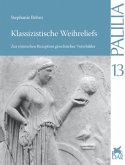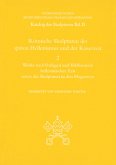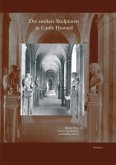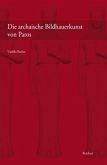Dieser Band führt die 1991 begonnene Katalogreihe fort, die erste bebilderte Publikation zu dieser Abteilung der Päpstlichen Sammlungen. Die Materialauswahl von 197 Stücken ist im Hauptteil dem Ausstattungsluxus von Villen und Gärten gewidmet. Reliefs, Wandverkleidungen, Schmuckaltäre, Brunneneinfassungen, Kandelaber, steinernes Mobiliar, Prunkgefäße und Steingerät sind erfasst. Die 17 griechischen Originalskulpturen der päpstlichen Sammlungen wurden 1988 komplett in die Museumsabteilung überführt. Da Grab- und Votivreliefs in römischen Villengärten aufgestellt waren, wird der Blick auf diesen Bereich sinnvoll ergänzt. Die Monumente orientalischer Kulte, 23 Stücke, sind durch Rundskulpturen ergänzt, um den inhaltlichen Zusammenhang und auch den der Fundorte zu wahren.
Hinweis: Dieser Artikel kann nur an eine deutsche Lieferadresse ausgeliefert werden.
Hinweis: Dieser Artikel kann nur an eine deutsche Lieferadresse ausgeliefert werden.
"Es lohnt sich auf jeden Fall auch für diejenigen, die sich sonst nur für die amerikanische Archäologie interessieren, in diese Berichte einmal hineinzusehen. (...) Insgesamt bieten beide Bände sehr umfangreiche und aufschlussreiche Informationen, die sich auch auf grund ihrer Aktualität sonst kaum finden lassen. "
Von MK
In: AmerIndian Research, Bd. 10/1, 2015, Nr. 35, S. 54-55.
--------------------------------------
"The volume (like the series) embodies the German catalogue at both its best and worst. What it offers is close, descriptive, analytical engagement, accompanied by a superb album of high-quality photographs (in addition to the 112 plates, 44 drawings are incorporated into the text (...)). Each entry follows the same tried and tested formula: first comes the
information about provenance; then the size, bibliography (although many pieces are published here for the first time), material and extant state; finally, after the lengthy description, we find discussion of date and a deluge of detailed endnotes (no. 38 has a hefty seventy-seven notes attached). It is a conservative presentational mode. But it would be wrong to think questions of social and cultural context are necessarily eelipsed. The majority of the pieces have no recorded provenance: the numerous iconographic and stylistic comparanda therefore construct art-historical 'contexts' of their own. Also noteworthy is the art historical interest in "Nachleben" (as in no. 192., compared to an engraving by Marco Dente da Ravenna, c. 1520). When done well, as here, the catalogue has the potential to take readers in a11 sorts of new and exciting interpretative directions.
That said, Anglo-Saxon readers will find many of their own intelleetual interventions under-represented in the volume. For all the scholarly furore in the Anglophone world, Kopienkritik flourishes here - refleeted not only in the book's structure (Greek before Roman), but also in its thematicorganization (e.g. section V.A.I, on 'Kopien nach Originalen des 5. und 4. Jhs. v. Chr.').
(...) These larger ideological questions should not detract from the many virtues of the book. The volume will be a must-have for every serious research library, and S. is to be congratulated on carrying out the task with such meticulous aplomb. As the German Classical archaeological tradition knows full weil, it is only after formally engaging with an object that we can tackle its various socio-cultural meanings. Anglophone scholarship might diss the genre of the catalogue. But we abandon its formalist rigour at our peril."
Michael Squire
In: Journal of Roman Studies. 101 (2011). pp. 312-313.
--------------------------------------
"The papal, bright yellow binding's colour makte sthe book a merry item in the bookshelves among mostly grey and dark-blue bindings. The content make the reader still luckier, since interesting categories of sculpture are discussed.(...)
The rich book concludes with five modern items in the style of Greco-Roman sculptures, the most fascinating of which are two fighting men, probably made after a drawing by Raphael "all'antica". To be sure, this short review cannot do justice to the richness of information provided. But undoubtedly, hte reader will appreciate the thorough discussions presented in this good, genuinely German product of Forschung. We see forward to the next volumes of this important series."
In: Babesch. 83.(2008). S. 206-207.
--------------------------------------
"Am Standard dieser fünf Lateran-Bände müssen sich künftige deutschsprachige Skulpturenkataloge messen lassen."
In: Museum Helveticum. 64 (2007). S. 184-185.
Von MK
In: AmerIndian Research, Bd. 10/1, 2015, Nr. 35, S. 54-55.
--------------------------------------
"The volume (like the series) embodies the German catalogue at both its best and worst. What it offers is close, descriptive, analytical engagement, accompanied by a superb album of high-quality photographs (in addition to the 112 plates, 44 drawings are incorporated into the text (...)). Each entry follows the same tried and tested formula: first comes the
information about provenance; then the size, bibliography (although many pieces are published here for the first time), material and extant state; finally, after the lengthy description, we find discussion of date and a deluge of detailed endnotes (no. 38 has a hefty seventy-seven notes attached). It is a conservative presentational mode. But it would be wrong to think questions of social and cultural context are necessarily eelipsed. The majority of the pieces have no recorded provenance: the numerous iconographic and stylistic comparanda therefore construct art-historical 'contexts' of their own. Also noteworthy is the art historical interest in "Nachleben" (as in no. 192., compared to an engraving by Marco Dente da Ravenna, c. 1520). When done well, as here, the catalogue has the potential to take readers in a11 sorts of new and exciting interpretative directions.
That said, Anglo-Saxon readers will find many of their own intelleetual interventions under-represented in the volume. For all the scholarly furore in the Anglophone world, Kopienkritik flourishes here - refleeted not only in the book's structure (Greek before Roman), but also in its thematicorganization (e.g. section V.A.I, on 'Kopien nach Originalen des 5. und 4. Jhs. v. Chr.').
(...) These larger ideological questions should not detract from the many virtues of the book. The volume will be a must-have for every serious research library, and S. is to be congratulated on carrying out the task with such meticulous aplomb. As the German Classical archaeological tradition knows full weil, it is only after formally engaging with an object that we can tackle its various socio-cultural meanings. Anglophone scholarship might diss the genre of the catalogue. But we abandon its formalist rigour at our peril."
Michael Squire
In: Journal of Roman Studies. 101 (2011). pp. 312-313.
--------------------------------------
"The papal, bright yellow binding's colour makte sthe book a merry item in the bookshelves among mostly grey and dark-blue bindings. The content make the reader still luckier, since interesting categories of sculpture are discussed.(...)
The rich book concludes with five modern items in the style of Greco-Roman sculptures, the most fascinating of which are two fighting men, probably made after a drawing by Raphael "all'antica". To be sure, this short review cannot do justice to the richness of information provided. But undoubtedly, hte reader will appreciate the thorough discussions presented in this good, genuinely German product of Forschung. We see forward to the next volumes of this important series."
In: Babesch. 83.(2008). S. 206-207.
--------------------------------------
"Am Standard dieser fünf Lateran-Bände müssen sich künftige deutschsprachige Skulpturenkataloge messen lassen."
In: Museum Helveticum. 64 (2007). S. 184-185.








